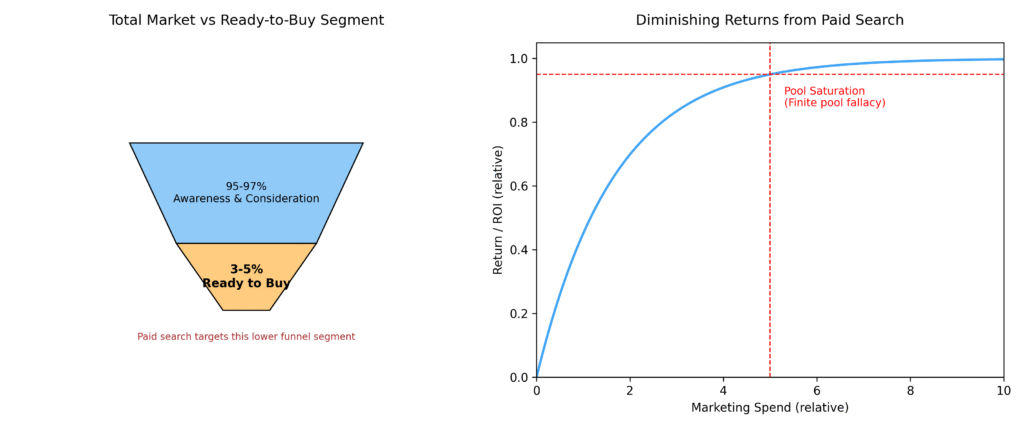Why is my PPC performance declining?
The slow and inevitable decline in your PPC performance is probably one of the biggest challenges facing your marketing team today. And while you might attribute diminishing returns to increased competition or platform changes, the root cause often lies in a fundamental misunderstanding of market dynamics and customer lifecycle management. And today, I want to dive into the nature of PPC campaigns and why you might be experiencing diminishing returns after a strong start.
The Lower Funnel Trap: Understanding PPC’s Natural Limitations
Paid Search campaigns inherently target the lower funnel. These campaigns are great at capturing users with high commercial intent, through transactional keywords like “buy,” “best price,” “discount,” and product-specific terms. The conversion rates can be super compelling, the attribution is clear, and the ROI calculations are pretty black and white – it’s why C Suite execs love them. It’x 10x easier to report back to key stakeholders when you can deliver a report as simple as “we spend x, we get y in return”.
However, this approach creates what marketing strategists call the “finite pool fallacy.” The assumption that the pool of ready-to-buy customers remains constant overlooks critical market dynamics.

Every product category has a finite number of consumers ready to purchase at any given moment. This pool typically represents just 3-5% of the total addressable market, depending on the industry. Once you’ve captured your share of this segment, continued investment in the same tactics yields diminishing returns through market saturation mechanics.
The lifecycle reality compounds this challenge. High-intent customers who convert through PPC campaigns exit the market temporarily or permanently after purchase. For B2B software, this might mean a 2-3 year contract period. For consumer durables, it could be several years before they re-enter the consideration phase.
Meanwhile, competitive displacement occurs systematically. As you focus exclusively on bottom-funnel capture, competitors investing in full-funnel strategies erode your future pipeline by engaging prospects during their research and consideration phases.
The Market Regeneration Problem
The fundamental issue isn’t that PPC stops working – it’s that you’re fishing in an increasingly depleted pond while neglecting the streams that feed it. Market regeneration occurs continuously, but through mechanisms that bypass bottom-funnel tactics entirely.
Demographics, life changes, business growth, and evolving needs continuously introduce new prospects to your category. However, these individuals rarely enter at the bottom of the funnel with immediate purchase intent. They begin their journey in the research and discovery phase, far from commercial search queries.
Prospects develop awareness of their problems gradually through what behavioural psychologists call “problem recognition evolution.” A SaaS company might find that businesses don’t immediately search for “project management software” but first search for “how to improve team productivity” or “why projects fail.” This gradual awareness development creates opportunities for early engagement that pure PPC strategies miss entirely.
Modern buyers conduct extensive research before entering commercial search queries. Studies show B2B buyers complete 67% of their journey before engaging vendors directly. During this research phase, they’re forming preferences and eliminating options based on the content and expertise they encounter.
Why Late-Stage Engagement Fails
When brands focus exclusively on lower-funnel PPC, they create what behavioural economists call “cold transaction bias.” Customers encounter your brand for the first time at the moment of highest friction – when they’re being asked to make a purchase decision.
This creates an immediate trust deficit. Prospects who haven’t previously interacted with your brand lack the familiarity and trust that comes from repeated exposure. This psychological barrier increases cost-per-acquisition and reduces conversion rates over time, creating a vicious cycle of increasing spend for decreasing returns.
The competitive disadvantage becomes pronounced when measured against brands that have nurtured prospects through content marketing, email sequences, and organic touchpoints. These relationships translate into higher conversion rates, larger average order values, and greater customer lifetime value. The competitor who educated your prospect about the problem is often the one who gets the sale.
Perhaps most insidiously, this problem remains largely invisible in last-click attribution models. You can’t measure the customers you never had the opportunity to nurture, making it difficult to quantify the true cost of lower-funnel-only strategies.
SEO as the Strategic Growth Engine
SEO represents the antithesis of PPC’s temporal limitations. While PPC provides immediate visibility for a price, SEO builds sustainable competitive advantages through compound growth effects that strengthen over time.
SEO naturally spans the entire customer journey through full-funnel engagement. Informational content captures prospects during problem recognition and research phases, while product and category pages convert prospects ready to purchase. This creates multiple touchpoints that build familiarity and trust over extended periods, dramatically improving conversion rates when prospects finally reach purchase readiness.
Unlike PPC, where stopping spend immediately eliminates visibility, SEO builds momentum through market share compound effects. Each piece of ranking content continues generating traffic and leads indefinitely, creating what Warren Buffett would recognise as an “economic moat”; sustainable competitive advantages that compound over time rather than depreciate.
The educational component proves crucial in complex B2B sales cycles and high-consideration consumer purchases. SEO content serves dual purposes: attracting traffic and educating prospects. Well-executed content marketing through SEO creates informed buyers who convert at higher rates and demonstrate greater lifetime value because they understand both their problem and your solution.
Why SEO Provides Superior Long-Term ROI
Let’s be clear here – SEO and PPC together, in concert, is an incredibly powerful approach to search marketing when done right. The core problem to highlight here is when brands become over reliant on paid search. So let’s dive into the cumulative impact of investing in SEO.
Cumulative Traffic Value
A piece of content ranking for valuable keywords generates traffic continuously. While the initial investment in content creation and optimisation might match several months of PPC spend, the traffic generated over 2-3 years often exceeds PPC traffic by orders of magnitude.
Keyword Portfolio Expansion
SEO naturally captures long-tail variations and semantic keyword opportunities that would be prohibitively expensive in PPC. This expanded keyword coverage increases total addressable traffic while reducing per-visitor acquisition costs.
Trust and Authority Signals
Search engines increasingly prioritise websites demonstrating expertise, authoritativeness, and trustworthiness (E-A-T). This creates a virtuous cycle where strong SEO performance enhances overall domain authority, improving rankings across all content.
Cross-Channel Performance Enhancement
Strong organic presence improves PPC performance through several mechanisms: higher quality scores from improved landing page relevance, increased brand recognition improving ad click-through rates, and reduced customer acquisition costs through improved conversion rates on paid traffic.
The Optimal Approach
The solution isn’t abandoning PPC but rather integrating it within a comprehensive growth strategy that prioritises sustainable competitive advantages.
Budget Allocation Strategy
Growth-focused companies typically allocate 60-70% of their search marketing budget to SEO and content marketing, with 30-40% dedicated to PPC for immediate revenue generation and market testing.
Temporal Planning
PPC provides immediate cash flow while SEO investments mature. This requires viewing marketing as an investment portfolio with different risk profiles and return timelines rather than quarterly expense management.
Competitive Intelligence
Monitor competitors’ content strategies and keyword positioning to identify gaps in your SEO coverage.
Customer Journey Mapping
Develop content that addresses each stage of your customer’s journey, from initial problem recognition through post-purchase advocacy. This comprehensive approach ensures continuous prospect nurturing and reduces dependency on expensive lower-funnel tactics.
The Future-Proofing Imperative
The decline in PPC performance isn’t a platform problem, it’s a strategic problem. Throwing more and more budget at at increasingly declining pool of consumers is not a long term growth strategy that any brand will benefit from.
Not sure what steps to take with your SEO strategy? Take our free 3 minute questionnaire and you’ll receive an action plan.
assess your seo performance level


